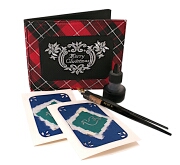Merry Christmas Eve everyone!
The Candy cane
|
|
It was not long after Europeans began using Christmas trees that special decorations were used to adorn them. Food items, such as candies and cookies, were used predominately and straight white candy sticks were one of the confections used as ornamentation. Legend has it that during the 17th century, craftsmen created the white sticks of candy in the shape of shephreds’ crooks at the suggestion of the choirmaster at the Cologne Cathedral in Germany.
The candy treats were given to children to keep them quiet during ceremonies at the living creche, or Nativity scene, and the custom of passing out the candy crooks at such ceremonies soon spread throughout Europe. |
According to the National Confectioner’s Association, in 1847 German immigrant August Imgard used the candy cane to decorate a Christmas tree in Wooster, Ohio. More than 50 years later, Bob McCormack of Albany, Georgia supposedly made candy canes as treats for family, friends and local shopkeepers. McCormack’s brother-in-law, Catholic priest Gregory Keller, invented a machine in the 1950s that automated the production of candy canes, thus eliminating the usual laborious process of creating the treats and the popularity of the candy cane grew.
More recent explanations of the candy cane’s symbolism hold that the color white represents Christ’s purity, the red the blood he shed, and the presence of three red stripes the Holy Trinity. While factual evidence for these notions does not exist, they have become increasingly common and at times are even represented as fact. Regardless, the candy cane remains a favorite holiday treat and decoration.
Christmas cards
|
|
A form of Christmas card began in England first when young boys practiced their writing skills by creating Christmas greetings for their parents, but it is Sir Henry Cole who is credited with creating the first real Christmas card. The first director of London’s Victoria and Albert Museum, Sir Henry found himself too busy in the Christmas season of 1843 to compose individual Christmas greetings for his friends.
He commissioned artist John Calcott Horsley for the illustration. The card featured three panels, with the center panel depicting a family enjoying Christmas festivities and the card was inscribed with the message “A Merry Christmas and a Happy New Year to You.” Read more about Christmas Cards |
Rudolph the Red-nosed Reindeer
 |
The Chicago-based Montgomery Ward company, department store operators, had been purchasing and distributing children’s coloring books as Christmas gifts for their customers for several years. In 1939, Montgomery Ward tapped one of their own employees to create a book for them, thus saving money. 34-year old copywriter Robert L. May wrote the story of Rudolph the Red-nosed Reindeer in 1939, and 2.4 million copies were handed out that year. Despite the wartime paper shortage, over 6 million copies had been distributed by 1946.
May drew in part on the story “The Ugly Duckling” and in part from his own experiences as an often taunted, small, frail youth to create the story of the misfit reindeer. Though Rollo and Reginald were considered, May settled on Rudolph as his reindeer’s name. |
Writing in verse as a series of rhyming couplets, May tested the story as he went along on his 4-year old daughter Barbara, who loved the story
Sadly, Robert Mays wife died around the time he was creating Rudolph, leaving Mays deeply in debt due to medical bills. However, he was able to persuade Sewell Avery, Montgomery Ward’s corporate president, to turn the copyright over to him in January 1947, thus ensuring May’s financial security.
May’s story “Rudolph the Red-Nosed Reindeer” was printed commercially in 1947 and in 1948 a nine-minute cartoon of the story was shown in theaters. When May’s brother-in-law, songwriter Johnny Marks, wrote the lyrics and melody for the song “Rudolph the Red-Nosed Reindeer”, the Rudolph phenomenon was born. Turned down by many musical artists afraid to contend with the legend of Santa Claus, the song was recorded by Gene Autry in 1949 at the urging of Autry’s wife. The song sold two million copies that year, going on to become one of the best-selling songs of all time, second only to Bing Crosby’s “White Christmas”. The 1964 television special about Rudolph, narrated by Burl Ives, remains a holiday favorite to this day and Rudolph himself has become a much-loved Christmas icon.
Make sure to get your sexy butts to bed tonight so Santa stops in at your house:) Higs and Kisses all and best of wishes for the Holidays:)
xxx
Brandi




















